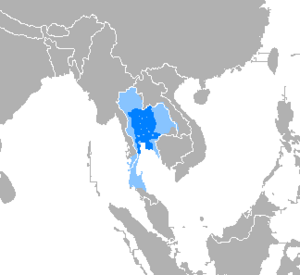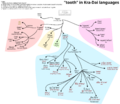Thai language facts for kids
Quick facts for kids Thai |
||||
|---|---|---|---|---|
| Central Thai, Siamese ภาษาไทย, Phasa Thai |
||||

"Phasa Thai" (literally meaning "Thai language") written in Thai script
|
||||
| Region | ||||
| Ethnicity | Central Thai, Thai Chinese, Mon, Lao Wiang, Phuan | |||
| Native speakers | L1: 21 million (2000)e27 L2: 40 million (2001) Total: 61 million |
|||
| Language family |
Tai–Kadai
|
|||
| Writing system |
|
|||
| Official status | ||||
| Official language in | ||||
| Recognised minority language in | ||||
| Regulated by | Royal Society of Thailand | |||
| Linguasphere | 47-AAA-b | |||

Dark Blue: Majority Light Blue: Minority
|
||||
|
|
||||
|
||||
Thai, also known as Central Thai, is a language spoken by the Thai people. It belongs to the Kra–Dai language family. You'll hear it mainly in Central Thailand. It's also spoken by many Thai Chinese, Mon, Lao Wiang, and Phuan people. Thai is the only official language of Thailand.
It's the most spoken language in Thailand, with over 69 million speakers (as of 2020). More than half of its words come from languages like Pali, Sanskrit, Mon, and Old Khmer. Thai is a tonal language, meaning the pitch of your voice changes the word's meaning. It also has a special writing system. Spoken Thai is quite similar to Lao and Isan. These languages are written a bit differently but are very much alike.
Many people in northern and northeastern Thailand speak both Central Thai and their local languages. This is because Central Thai is used on TV, in schools, and in the news. So, most people learn it.
Contents
How Thai Language is Grouped
Thai is part of a bigger language family called Kra-Dai. It's specifically a "Chiang Saen" language. Other languages in this group include Northern Thai and Southern Thai. These are all part of the Southwestern Tai languages.
Standard Thai is the main language used in schools and government. It's based on the way people speak in central Thailand. It is written using the Thai script.
The History of Thai
The Thai language has changed a lot over time. Its writing system is about 800 years old. Many of these changes can still be seen in how Thai is written today.
Early Days of Thai
Long ago, during the Ming dynasty (1405–1433), a Chinese traveler named Ma Huan wrote about the language of the Ayutthaya Kingdom. He said it sounded a bit like a local language in Guangdong, China. The old capital of Thailand, Ayutthaya, was a place where people spoke both Thai and Khmer.
Over time, more and more people started speaking only Thai. Because of this, many Khmer words and grammar rules became part of the Thai language. This made the Thai spoken in the later Ayutthaya Period a mix of Thai and Khmer. Even today, many Thai words come from Khmer.
Thai also borrowed words from Pali, especially for religious terms related to Buddhism.
Old Thai Language
Old Thai had different ways of saying words based on their tone. It also had different consonant sounds. A big change happened between 1300 and 1600 CE. Many consonant sounds merged, and this led to new tone differences.
This is why modern Thai spelling can seem complicated. The way a word is spelled often shows how it sounded in Old Thai. For example, some modern Thai consonants used to be voiced (like 'b' or 'd') in Old Thai. Others were voiceless (like 'p' or 't'). These differences affected the tones of words.
How Thai Sounds (Phonology)
Thai has specific sounds for consonants and vowels. It's important to know these sounds to speak Thai correctly.
Starting Consonant Sounds
Thai has three main types of starting consonant sounds:
- Voiced: Like the 'b' in "bat".
- Tenuis: Unvoiced and unaspirated, like the 'p' in "spin" (not "pin").
- Aspirated: Unvoiced and with a puff of air, like the 'p' in "pin".
This means Thai has more distinct 'p' and 't' sounds than English.
Ending Consonant Sounds
When consonants are at the end of a syllable, they often sound different. For example, 'b' and 'd' sounds become 'p' and 't' sounds at the end of a word. Also, sounds like 'k', 'p', and 't' at the end of a word are not fully released.
Consonant Groups (Clusters)
In Thai, each part of a word (syllable) is spoken separately. In most Thai words, you'll only find groups of two consonants at the beginning of a syllable. For example, "กร" (gr) or "กล" (gl). More complex groups of consonants usually appear in words borrowed from other languages.
Vowel Sounds
Thai has many different vowel sounds. Each vowel sound can be either short or long. This length difference can change the meaning of a word. For example, a short 'a' sound might mean one thing, while a long 'a' sound means something else.
There are also sounds that combine two vowels (diphthongs) or three vowels (triphthongs).
Tones in Thai
Thai is a tonal language. This means the way you say a word (the pitch of your voice) changes its meaning. There are five main tones in Thai:
- Mid tone: A flat, middle pitch.
- Low tone: A low, flat pitch.
- Falling tone: Starts high and goes down.
- High tone: A high, flat pitch.
- Rising tone: Starts low and goes up.
For example, the word "ma" can mean "horse," "dog," "come," or "mother" depending on the tone you use!
Thai Grammar
Thai grammar is quite simple compared to some languages. Words don't change much based on who is speaking or when something happened.
Adjectives and Adverbs
In Thai, words that describe things (adjectives) or describe actions (adverbs) look the same. They always come after the word they are describing.
Verbs
Thai verbs don't change their form. For example, the verb "to eat" stays the same whether it's "I eat," "he eats," or "they ate." To show when something happened (past, present, future), Thai uses small words called "auxiliary verbs" or "markers" before or after the main verb.
For example:
- To show something is happening now, you might use กำลัง (kamlang) before the verb. It's like adding "-ing" in English.
- To show something is finished, you might use แล้ว (laeo) after the verb.
- To talk about the future, you can use จะ (cha) before the verb.
To say "not," you put ไม่ (mai) before the verb.
- เขาไม่ตี (khao mai ti) means "He is not hitting" or "He doesn't hit."
Nouns
Thai nouns also don't change their form. They don't have genders (like "he" or "she" for objects). There are no words like "a," "an," or "the."
To talk about more than one of something (plural), Thai uses "classifiers." These are special words that go with numbers. For example, instead of "four chairs," Thai says "chair four item."
To show who something belongs to, you can use ของ (khong) before the person or thing. For example, "my mother" is แม่ของผม (mae khong phom), which means "mother of I." Often, ของ is left out.
Pronouns
Thai has many different words for "I," "you," "he," "she," and "they." The word you choose depends on who you are talking to, their age, and their social status. Sometimes, people use nicknames instead of pronouns.
For example:
- ผม (phom) is "I" for boys and men.
- ดิฉัน (dichan) is "I" for girls and women (formal).
- ฉัน (chan) is "I" for girls and women (common).
- คุณ (khun) is a common word for "you."
Particles
Thai often adds small words called "particles" to the end of sentences. These words don't have a direct meaning but show politeness, a request, or other feelings. They are like how your voice changes to show a question or excitement in English.
The most common polite particles are:
- ครับ (khrap) for boys and men.
- ค่ะ (kha) for girls and women.
Other particles include:
- นะ (na): Makes a sentence sound softer or friendlier.
- สิ (si): Adds emphasis or gives a gentle command.
Different Ways of Speaking Thai
Thai has different "registers" or styles of speaking for different situations:
- Street or Common Thai: This is informal Thai, used with family and close friends.
- Elegant or Formal Thai: This is used in official settings and in writing, like in newspapers.
- Rhetorical Thai: Used for public speaking.
- Religious Thai: Used when talking about Buddhism or to monks.
- Royal Thai: Used when speaking to or about the royal family.
Most Thai people understand all these styles. The common and formal styles are used every day. The other styles are taught in schools.
For example, the word "to eat" can be said in many ways:
- กิน (kin): Common way to say "eat."
- รับประทาน (rapprathan): A more formal and polite way to say "eat."
- ฉัน (chan): Used when talking about monks eating.
- เสวย (sawoei): Used when talking about the royal family eating.
Thai Words from Other Languages
Many Thai words come from other languages.
- Chinese: Many words were borrowed from Chinese languages, especially in the past.
- Khmer: The Khmer language, spoken in Cambodia, greatly influenced Thai. Over 2,500 Thai words come from Khmer.
- Sanskrit and Pali: These ancient Indian languages, especially Pali (used in Buddhism), gave Thai many formal and religious words.
- English: Since the 1900s, English has given Thai many words, especially for science, technology, and modern things.
- Other languages: Thai also has words from Arabic, French, Japanese, Malay, Portuguese, and Tamil.
Thai Writing System
Thai is written using the Thai script. It's written from left to right. The Thai script and language are very similar to the Lao language and its script. Most people who can read Lao can also read Thai.
The Thai writing system was created by changing the Khmer script. The oldest Thai writings are from around 1292 CE.
Here are some cool things about the Thai script:
- It's an abugida. This means that each consonant letter has a small, hidden vowel sound unless another vowel is written.
- Special marks for tones are placed above the last consonant of a syllable.
- Vowel letters can appear before, after, above, or below the consonant they belong to.
How Thai is Written in English Letters
There isn't one perfect way to write Thai words using English letters. For example, the main airport's name can be written as Suvarnabhumi, Suwannaphum, or Suwunnapoom. Because of this, it's best to learn the Thai script if you want to truly understand the language.
The official way to write Thai in English letters is called the Royal Thai General System of Transcription (RTGS). This system is used on road signs in Thailand. However, it doesn't show the tones or how long a vowel sound is.
Images for kids
See also
 In Spanish: Idioma tailandés para niños
In Spanish: Idioma tailandés para niños
- Thai script
- Thai honorifics
- Thai literature
- Thai numerals
- Thai braille
- Thai typography
- Comparison of Lao and Thai










